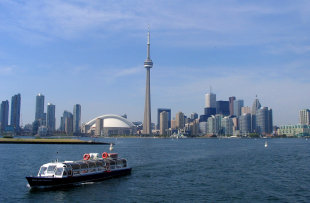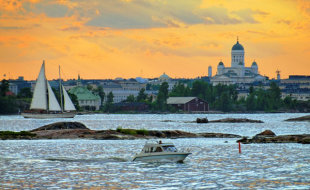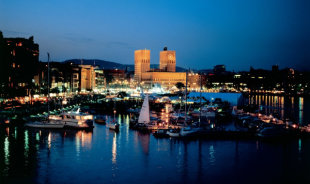2012 is sure to be filled with too many end-of-the-world jokes, and probably a fair amount of genuine fear as well.
But assuming the Mayans were wrong and doomsday isn’t on Dec. 21 this year, you may be wondering how the world as we know it might really end. We’ve collected several scientifically valid scenarios for you to worry about.
Supervolcano
The chances of an earthquake unzipping the world’s fault system are negligible, says seismologist Thorne Lay of the University of California, Santa Cruz.
This is because the energy released by a quake is related to the length of the fault that is ruptured during the event. For example, the 2004 magnitude 9.1 Sumatra quake that triggered the Indian Ocean tsunami and killed nearly 300,000 people, ruptured around 900 miles of a subduction zone fault, the longest ever recorded for a single quake. But the major fault zones that mark boundaries between tectonic plates are not continuous, and irregularities like changes in the type of faulting and the existence of smaller plates with shorter boundaries stop ruptures short of apocalyptic lengths.
But other geologic hazards may have more potential for doom.
“It’s more plausible that you have a truly mammoth eruption,” like an eruption of the supervolcano that lies beneath the Yellowstone National Park area, Lay said. Yellowstone has experienced colossal volcanic explosions in the past, most recently 2 million and 640,000 years ago. Another such mega eruption would be devastating for much of North America, he says.
Giant eruptions have contributed to mass extinctions, including the one that killed off the dinosaurs around 65 million years ago. At that time, volcanoes spewed out a roughly 2,000-foot-deep layer of lava to form part of the 10,000-foot-thick Deccan Traps of India, the world’s largest lava beds, geophysicist Anne-Lise Chenet of the Paris Geophysical Institute wrote in an email. And scientists have also shown that a Siberian volcano may have precipitated the largest extinction on record about 250 million years ago. These blazing behemoths belched out so much sulfur, carbon dioxide and ash that they may have altered the climate enough to collapse the food chain, Lay says.
Yellowstone’s giant volcanic crater has risen about 10 inches in the last decade, suggesting molten rock may be building up underneath. During its lifetime, the megavolcano has probably experienced more than a dozen giant eruptions, Lay says. Lately, it’s been blowing off steam through little vents, but it’s unclear whether it’s gearing up for another Earth-shattering blast.

Asteroid Accident
Asteroids typically top the list of extraterrestrial objects that could hit Earth. A 9-mile wide asteroid that crashed into what is now Mexico’s Yucatan Peninsula was partly responsible for the dinosaurs’ extinction about 65 million years ago.
The 2004 announcement that 900-foot long Apophis had more than a 2 percent chance of colliding with Earth in 2029 revved up research on asteroid detection and defense, when scientists recalculated the odds down to 1 in 250,000.
Luckily, nothing of that size is in Earth’s path currently, so “we may be safe for at least a few million years,” said planetary scientist Jay Melosh of Purdue University.
But smaller threats may be looming.
NASA expects that roughly every 100 years, an asteroid larger than 55 yards wide will strike. The impact could cause local catastrophes like massive floods, destruction of entire cities and agricultural collapse. Around once every few 100,000 years, chunks of rock more than three-fifths of a mile wide — the equivalent of about 12 New York City blocks — could come tumbling through the atmosphere causing much more serious problems, on a global scale. Acid rain would kill crops, debris would shield Earth from sunlight, and firestorms would ensue, according to NASA’s Near Earth Object Program.
To understand our cosmic risks, scientists are inspecting the solar system to find asteroids that may be heading our way, said UCSC planetary scientist Erik Asphaug. They’ve discovered about 900 of an estimated 1,000 asteroids wider than three-fifths of a mile thought to have an Earth-crossing orbit. None appears to have Earth as its target.
“The plain vanilla odds are very low” that anything already discovered of that size will strike in the near future, Asphaug said. But that doesn’t mean Earth is 100 percent safe.
It’s close to impossible to find every asteroid that could be a threat to Earth.
“There’s always some uncertainty that we’re going to have to live with,” he said. “Or die with.”

Comet Collision
Some of that uncertainty comes from asteroids’ sometimes forgotten cousins, comets. (Comets are made up of ice and dust, while asteroids are made up of rock and metals.)
Hartley 2 came within 11 million miles of Earth on Oct. 20, which was among one of the closest times a comet has gotten to Earth in centuries.
“Comets are especially dangerous because they are coming from farther distances, at higher velocities,” Asphaug said.
Comets zoom through space at almost 100,000 mph and pick up speed due to Earth’s gravitational pull, he said. The faster an object moves, the bigger the force it exerts on whatever it happens to hit and the more energy it deposits. For Earth, that means more damage. For humans, it may spell out R.I.P.
To add insult to potential injury, finding comets in the outer solar system is very difficult because these dirty snowballs are extremely dark.
But when comet gets within about 390 million miles from Earth, the sun heats comets’ dark surface and starts to warm its icy interior, making it spew out the dust and gas that form its distinctively bright tails.
Assuming astronomers developed the technology to discover Earth-bound comets farther away than Jupiter, scientists might have about 10 years before a comet hit Earth in a worst case scenario, Asphaug said.
But “if there’s a 10-kilometer (6-mile) hunk of ice and rock that’s heading straight toward the Earth,” he added, “there aren’t very many options there, except to do the Bruce Willis thing,” and nuke it.

Algal Apocalypse
Another big problem for Earth could come from a tiny source, according to Caltech geobiologist Joe Kirschvink. He raises the possibility that diatoms — a type of microscopic algae that inhabit moist surfaces, lakes, rivers, oceans and soil — could alter Earth’s atmosphere in a fatal way.
These microbes live off fuel produced through photosynthesis, a process that converts light energy (photons) from the sun into energy a cell can use to function (sugar). As they photosynthesize, diatoms break up water into hydrogen and oxygen other organisms can then use to breathe.
But if mutant diatoms couldn’t use water — or other substances in their environment, like iron or hydrogen — they might be tempted to pick salt (sodium chloride) off Earth’s menu of molecules. These diatoms would release poisonous chlorine gas. Assuming the chlorine didn’t kill them and nothing else limited their growth, the diatoms would grow exponentially, setting off a death-by-inhalation doomsday.
“The damn thing could take the world over in a couple of million years,” Kirschvink said.
If his diatomical predictions pan out, it would be the second time biology issued a molecular death sentence for most living organisms on Earth. A similar scenario played out about 2.35 billion years ago when cyanobacteria, a type of blue-green bacteria, learned how to photosynthesize. The bacteria dumped oxygen molecules into the atmosphere — which until then was mostly carbon dioxide — and killed off species that couldn’t tolerate oxygen, Kirschvink says.
“Oxygen molecules at the time were unheard of in the environment,” he said. Once diatoms set in motion the “oxygen apocalypse,” there was no stopping them. They had an advantage over creatures that didn’t like oxygen.
Fortunately for Earth’s inhabitants today, the water microbes need to photosynthesize abounds, so it’s unlikely they’ll set off a chlorine apocalypse any time soon, Kirschvink said.

Killer Contagion
Lately, there’s been a lot of movie-fueled worry surrounding the possibility of a devastating global pandemic. Currently science is contributing to these fears in the form of a highly contagious lab-made variant of the H5N1 virus.
In case you missed it, American and Dutch scientists studying the virus in ferrets made the already deadly virus that much more dangerous by mutating some of its genes. Before the genetic changes were made, the virus could only spread through touch, but the mutations let it survive in the air, allowing it to pass between ferrets without the need for contact. The results sparked panic that the pathogen could leak out of the lab and trigger a pandemic.
But could a virus bring about the end of days?
Probably not, said Peter Katona, whose research at UCLA focuses on biological terrorism preparedness, though it would “wreak havoc.”
A single virus is unlikely to wipe out all humans or animals on Earth because there’s enough diversity that at least some would be resistant, agreed Caltech virologist Alice Huang.
Even the new lab strain of H5N1 virus, which only has five mutations, is similar enough to other versions of the flu virus that people would have some protection against it and it wouldn’t wipe out all life, Huang said.
“For a virus to kill all humans on Earth, it would have to kill rapidly, like a week or less,” Huang said. If it took any longer, the immune system would have time to attack it.
And the virus would have to infect most of the world’s population simultaneously.
Picture thousands of drones disseminating a killer virus with aerosols “to every nook and cranny” of the planet at once, she said.
Or ”you would have to imagine some new (highly virulent) pathogen that lived and reproduced in some unlikely place, like under ice caps or in deep sea water near hydrothermal vents,” she said. Then, the tiny predators would have to be spread far and wide, say by some huge natural disaster.
Because this is highly unlikely, Huang added, even science fiction usually imports apocalyptic pathogens from outer space.

Suicidal Supernova
Supernovas are among the most powerful explosions in the universe and can rival the strength of a few octillion nuclear warheads, according to NASA.
These super-booms come in two varieties: core-collapse supernovas, which happen when a giant star’s core collapses after 5 million to 20 million years of life; and type-1a supernovas which occur when a white dwarf star detonates after its core gets too dense.
In our galaxy, core-collapse supernovas occur two to four times more frequently than type-1a supernovas, says astronomer Todd Thompson of Ohio State University. And in the Milky Way, a core collapse tends to happen every 100 years or so, he says. Luckily, most will happen at a safe distance of 5 to 10 parsecs, or 16.5 to 33 light-years — too far away to do any real damage.
If supernovas occurred randomly throughout the Milky Way, Earth could expect one every 5 billion years. But because they congregate near the Milky Way’s spiral arms, “we would in fact expect to come within 10 parsecs of a supernova nearly every time we pass through a spiral arm, which is about every 100 million years,” Thompson said.
These stellar fireworks produce x-rays, cosmic rays — electrons, protons and nuclei zooming through space at nearly the speed of light, and gamma rays — light waves so powerful they’re capable of killing cells.
A supernova’s radiation would destroy the ozone in the atmosphere, increasing the amount of ultraviolet light that gets through. The UV flash could increase skin cancer rates; set off mass die-offs of bacteria and plankton; and precipitate another ice age, Thompson said.

Orbital Obliteration
Changes in how the planets circle the sun could also knock out Earth.
Jupiter is the most massive planet in the sun’s posse. As such, it tugs at the orbits of the other planets. Over millions of years, the gaseous giant could bully tiny Mercury’s elliptical orbit so much that the farthest distance it travels away from the sun increases, and the closest point gets closer.
As Mercury’s orbit stretches, the swift planet could crash into the sun, according to a 2008 study in theAstrophysical Journal. Alternatively, Mercury could cross Venus’ orbit and then “there’s a very short time until there’s a real disaster,” said UCSC astronomer Greg Laughlin, one of the study’s authors. Venus and Mercury’s kiss of death, he said, “could eject Mars from the solar system.”
But in the worst-case scenario, Mercury and Earth could collide. The impact would destroy Earth even though our planet has about 20 times the mass of Mercury.
Thinking about “orbits going unstable adds a little spice of danger” to planetary science, Laughlin said. But there’s only about a 1 percent chance any of these situations will pan out in the next 5 billion years.

Solar Slaughter
Even if the Earth dodges Mercury, the blue planet eventually will be turned into an oven by the sun, says NASA planetologist Chris McKay.
As the sun burns, the hydrogen in its core converts to helium by fusion, a process through which the nuclei of atoms meld together. Fusion produces a tremendous amount of heat. So as time passes, the 5 billion-year-old star gets hotter and brighter.
In about 1 billion years, scientists predict the sun will shine about 10 percent brighter than it does now. The extra energy will heat Earth to well over 200 F. The oceans will boil off, the climate will collapse and “any kind of real estate won’t be worth anything anymore,” said astrophysicist Klaus-Peter Schrœder of the University of Guanajuato in Mexico.
“We’ll have to look for a new planet.”
Those who don’t want to leave home will have to hope that Schrœder’s colleague, astronomer Robert Smith of the University of Sussex, is right. Smith suggests scientists may be able to enlarge Earth’s orbit by manipulating asteroids visiting our solar system.
Shifting the path of these rocky passers-by so that they move in front of Earth should create a slight pull on the planet and help to speed it up. Earth’s quicker pace would make its orbit slightly larger. If done enough times over millions of years, Earth’s orbit could swell by about 5 percent, which would translate into about 10 percent less solar energy reaching our planet, Schrœder said.
That may only buy the planet time, however. In about 7 billion years, Schrœder says, the sun will bloat into a red giant, a much brighter and voluminous version of its current self.
“It will be so big that the Earth will be inside the sun,” McKay said.
In the meantime, unless Smith’s orbital expansion works out, Earth will almost certainly cook and steam under the sun’s powerful rays.
“Not that I’m a great believer, but credit needs to be given sometimes,” Schrœder quipped. “The Bible’s predictions that we’ll end up in an eternal fire are somewhat accurate.”
Source: dailynewzforu





















